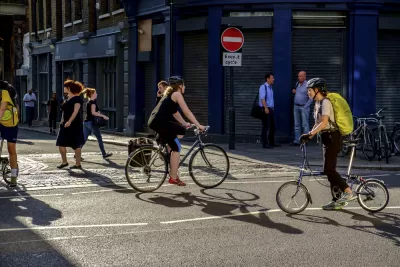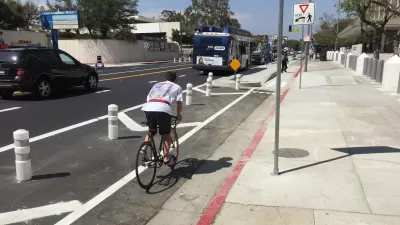Research from Europe shows bike infrastructure doesn't add to urban traffic and can shift mode share from cars to bikes and reduce the need for solo car trips.

Despite claims that cycle lanes added during the pandemic contributed to an increase in London's traffic congestion, research shows the city's traffic was largely the same in 2021 as in 2019, before the bike lanes were installed. David Metz reports that cycle lanes actually reduce the share of trips taken by car, which could diminish congestion as well. Thanks in part to aggressive measures taken by the city to discourage car trips, the use of private transport in London fell from 48 percent to 37 percent between 2000 and 2019.
"It’s important to note that creating cycle lanes reduces the space available for cars but does not necessarily get people out of cars. Copenhagen is a city famous for cycling, with 28 percent of journeys made by bike. Yet car traffic is only slightly less than in London." Meanwhile, residents of Copenhagen take only half as many public transit trips as Londoners. In fact, "there are no major European cities with high levels of both cycling and public transport. "
With revenues from public transit ridership drastically reduced by the pandemic, Metz writes, it is investments in cycling infrastructure that would "make the most sense for reducing car use in London."
FULL STORY: Why Cycle Lanes Aren’t Responsible for Urban Congestion

Planetizen Federal Action Tracker
A weekly monitor of how Trump’s orders and actions are impacting planners and planning in America.

Congressman Proposes Bill to Rename DC Metro “Trump Train”
The Make Autorail Great Again Act would withhold federal funding to the system until the Washington Metropolitan Area Transit Authority (WMATA), rebrands as the Washington Metropolitan Authority for Greater Access (WMAGA).

The Simple Legislative Tool Transforming Vacant Downtowns
In California, Michigan and Georgia, an easy win is bringing dollars — and delight — back to city centers.

The States Losing Rural Delivery Rooms at an Alarming Pace
In some states, as few as 9% of rural hospitals still deliver babies. As a result, rising pre-term births, no adequate pre-term care and "harrowing" close calls are a growing reality.

The Small South Asian Republic Going all in on EVs
Thanks to one simple policy change less than five years ago, 65% of new cars in this Himalayan country are now electric.

DC Backpedals on Bike Lane Protection, Swaps Barriers for Paint
Citing aesthetic concerns, the city is removing the concrete barriers and flexposts that once separated Arizona Avenue cyclists from motor vehicles.
Urban Design for Planners 1: Software Tools
This six-course series explores essential urban design concepts using open source software and equips planners with the tools they need to participate fully in the urban design process.
Planning for Universal Design
Learn the tools for implementing Universal Design in planning regulations.
Smith Gee Studio
City of Charlotte
City of Camden Redevelopment Agency
City of Astoria
Transportation Research & Education Center (TREC) at Portland State University
US High Speed Rail Association
City of Camden Redevelopment Agency
Municipality of Princeton (NJ)





























